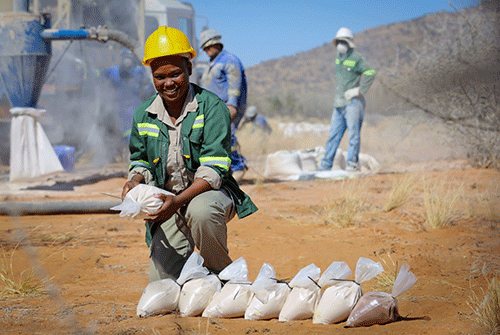Namibia will soon boast a new gold mine near the towns of Usakos, Karibib and Omaruru that is to be developed by Canadian company, Osino Resources. The development of the mine was confirmed this week following the results of the prefeasibility study for the Twin Hills gold project.
It said the project is set to become a viable open pit gold mine to support Namibia’s economic development. According to Osino Resources CEO Heye Daun, the group is very pleased with the results of the prefeasibility study which demonstrates the Twin Hills gold project does indeed have the potential to be developed into a long-life, low-cost and economically robust open pit gold operation.
“The study underlines that the gold project’s geology is consistent, its metallurgy is simple and that it involves low technical risk and low capital investment,” said Daun.
“Osino Resources is proud to deliver this prefeasibility study within three years of our discovery of the Twin Hills gold deposit, and our next objective is to optimise and improve the project further, advancing it to the construction stage in the next year.”
The Net Present Value (NPV) of the project at a gold price of US$1700/oz is US$783 million while the project still reflects a post-tax NPV of US$114 million in a stressed economic scenario where the gold price is US$1400/oz and an elevated discount rate of 10% is applied to the project.
Daun added that Osino expects to swiftly make significant progress with the permitting and financing of the project that will open the way for the continued fast tracking of Twin Hills. “I am looking forward to advancing Osino’s ambitions to build a gold mine with a 13-year lifespan and making a significant contribution to socio-economic development in Namibia in this way.”
The Twin Hills project is located within the prospective Damara sedimentary mineral belt and in close proximity to the producing Navachab and Otjikoto gold mines.
The Twin Hills prefeasibility study found that the gold project is financially viable at a gold price of US$1700/oz and will continue to be profitable in the event of changes in key project parameters at different gold prices.
“The analysis indicates that the project is robust and recommends that Twin Hills is progressed to the feasibility study level,” said Daun. The Twin Hills project is anticipated to be completed at an overall capital cost of US$375 million, boasting an investment payback period of 2.2 years. Its processing plant will have the capacity to process five million tons of ore per year and annual gold production for the first 10 years is expected to be 171,000 ounces at an all-in sustaining cost of US$909/oz.
“Osino will recover gold from the mined ore with a conventional 3-stage crushing, ball milling, gravity separation, pre-oxidation and carbon-in-leach (CIL) circuit,” said Daun.
“The orebody will primarily be mined as a conventional shovel and truck operation, with the mining operation outsourced to a reputable mining contractor.”
Daun noted the prefeasibility study opens the way for Osino Resources to bring its vision for Twin Hills to life.
“We are now focused on starting a definitive feasibility study for the project before the end of this year and starting project implementation as soon as we secure project finance.”


